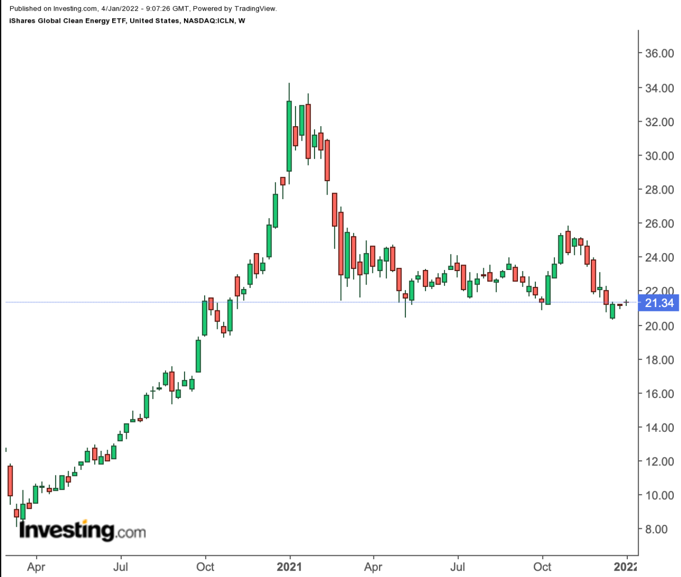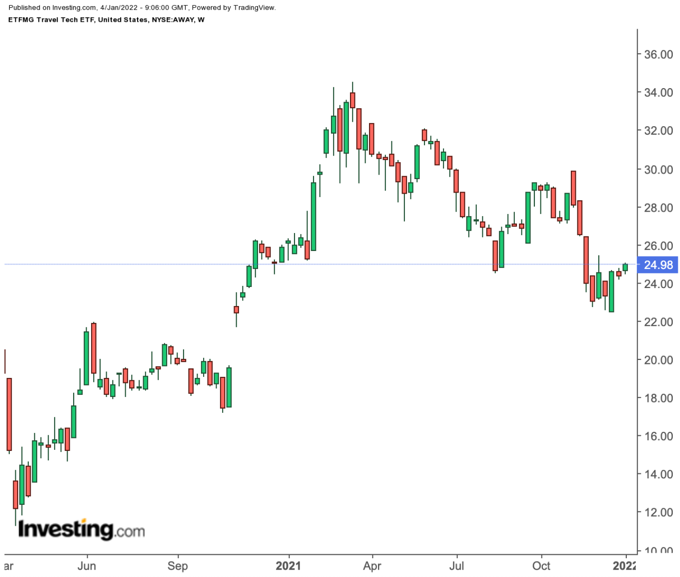Stock market today: Nasdaq closes above 23,000 for first time as tech rebounds
In 2021, not all sectors or exchange-traded funds (ETFs) were winners. Investors who believe there could be a sectoral rotation in the weeks ahead might consider researching some of those funds that closed the year in the red.
Today's article looks at two funds that could potentially see better returns in 2022.
1. iShares Global Clean Energy ETF
- Current Price: $21.34
- 52-Week Range: $20.30 - $34.25
- Dividend Yield: 1.18%
- Expense Ratio: 0.42% per year
According to the Organization for Economic Co-operation and Development (OECD), renewable energy sources include "hydro (excluding pumped storage), geothermal, solar, wind, tide and wave sources. Energy derived from solid biofuels, biogasoline, biodiesels, other liquid biofuels, biogases and the renewable fraction of municipal waste are also included."
Global decarbonization efforts have put alternative energy sources in the limelight and renewable sources account for about a fifth of the electricity generation in the US. In the European Union (EU), about 20% of all energy consumed comes from clean energy sources.
Therefore, readers who want to invest in global renewable energy names could research the iShares Global Clean Energy ETF (NASDAQ:ICLN). The fund was first listed in June 2008.

ICLN, which has 76 holdings, tracks the S&P Global Clean Energy Index. Over a third of businesses come from the US. Next in line are those from Denmark, China, Canada, Spain and Portugal.
Among the top four sectors of the fund are electric utilities (25.04%), semiconductor equipment (18.10%), renewable electricity (13.76%) and heavy electrical equipment (13.54%).
The ETF's net assets are close to $5.6 billion, with the 10 largest holdings constituting over half of that figure. Among the leading stocks on the roster are Enphase Energy (NASDAQ:ENPH), Consolidated Edison (NYSE:ED), Vestas Wind Systems (OTC:VWSYF), Orsted (OTC:DOGEF), SolarEdge Technologies (NASDAQ:SEDG) and Plug Power (NASDAQ:PLUG).
In the past 52 weeks, ICLN was down almost 25%. It had hit an all-time high on Jan. 8, 2021, nearly a year ago. Trailing P/E and P/B ratios are 25.14x and 2.88x, respectively. Long-term investors who believe the growth in renewable sources will likely continue could invest around these levels.
2. ETFMG Travel Tech ETF
- Current Price: $24.98
- 52-Week Range: $22.45 - $34.54
- Expense Ratio: 0.75% per year
In the initial months of the pandemic in 2020, travel shares suffered significantly. However, early 2021 brought optimism, due in part to the global vaccine rollout and in part to pent-up demand worldwide.
But in the last weeks of the year, the Omicron variant once again put pressure on the travel sector. For instance, over the past year, the Dow Jones Travel & Tourism and the Dow Jones Airlines indices are up about 2% and 1%.
Now as Wall Street debates how the new year could shape up for travel businesses, bulls point out that there has been a significant uptick in the number of air travelers.
According to metrics released by the US Transportation Security Administration (TSA), on Sunday, Jan. 2, 2022, the traveler throughput was 2,023,309.
By comparison, 52 weeks ago on Sunday, the number was 1,327,289. And two years ago, before COVID-19 had reached the US, it was 2,422,272. So, compared to last year, the numbers have increased significantly, approaching those before the pandemic entered our lives.
However, bears highlight that the Omicron variant still means a lot of question marks. Coupled with the uncertainty about inflation levels and how the US economy might play out in 2022, there could be headwinds ahead.
Our second fund might appeal to those long-term investors who believe a further recovery in the travel industry should be in the cards. The ETFMG Travel Tech ETF (NYSE:AWAY), which has 32 holdings, invests in travel and tourism companies that rely heavily on technology.

The leading ten names on the roster comprise around 45% of net assets of $260.5 million. Reservation platforms Expedia Group (NASDAQ:EXPE) and Booking (NASDAQ:BKNG); ride-hailing app Uber Technologies (NYSE:UBER); Spanish online travel group eDreams Odigeo (MC:EDRE); homestay platform Airbnb (NASDAQ:ABNB); and Australian hotel room commerce platform Siteminder (ASX:SDR) are among the most important stocks
AWAY began trading in February 2020, a few days before travel shares went into freefall at the start of the pandemic. Its opening price in 2020 was $25.04. The shares are now once again around $25.
In 2021, the ETF was down close to 5.5%. However, in March 2021, AWAY initially saw a record high of $34.54. But in December 2021, nervousness over COVID-19 pushed the fund to $22.45, a 52-week low. Buy-and-hold investors should put the fund on their radar with a view to invest between $23-24.
